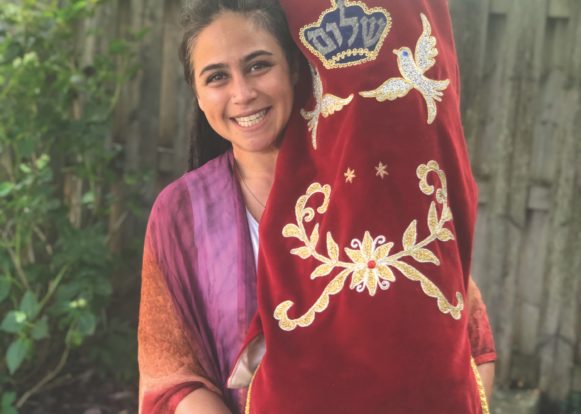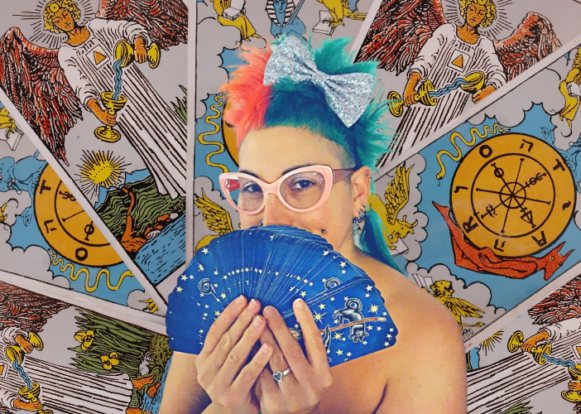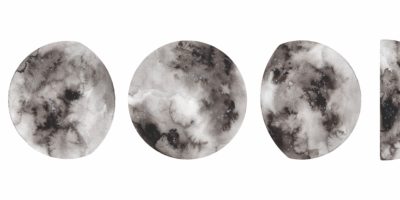Lilith Feature
Pagans, Priestesses & Witches… but Jewishly
by Arielle Silver-Willner
Spiritual ideas and practices that seemed shocking—or laughable—just a couple decades ago are moving more mainstream. Today’s feminist fusion of nature-centered power, forgotten “women’s wisdom” and Jewish mystical traditions have become very appealing. And why not? They blend environmentalism, a wide welcome for people with marginalized identities, and an earnestness about spiritual seeking that used to be utterly beyond the reach of institutions. This time, it looks like the Jewitches are here to stay.
For centuries, misogyny has made witchcraft synonymous with evil. In Colonial America, women who threatened norms were frequently accused of witchcraft and were punished with death. Practitioners of Indigenous religions were demonized too, seen as a threat to the “righteous” Christian lifestyle. The wicked-witch trope persists in myths and fairy tales—a villainous woman, usually older, who might offer you a poisoned apple and bake your children into a pie. And this fierce hatred is not unique to the Western world; countries on nearly every continent have similarly disturbing histories of “witch hunting.” In some places it continues today.
And yet as tales of the mythological “demon” Lilith (and this magazine’s title) remind us, for as long as there has been feminism, there’s been feminist reclamation of threatening female archetypes. In recent years we’ve seen yet another revival: “Jewitchery” has grown in popularity, and in associations. The Jewitches Instagram and TikTok accounts have 24K followers each, and more than 10K public Instagram posts and TikToks with millions of views use the Jewitch hashtag. There are also several Jewitch Facebook groups with thousands of members. The percolation of Jewitchery through social media points to its appeal to Gen Z and Millennials, as well as to its function as a tool for connection.
Originally the term referred to a sub-category of Semitic Neopaganism, a movement dedicated to resurrecting pre-patriarchal, earth-based spiritual traditions and beliefs—such as Wicca and goddess worship—in combination with Judaism. “[Jewitchcraft] is a way for a lot of us who have Jewish heritage in the Pagan community to reconnect with our ancestral traditions,” Starhawk, self-described Jewitch and scholar of paganism and Goddess worship, told Lilith. “ There were goddesses in Judaism for centuries.” It was not until a stricter, more patriarchal and monothesistic Jewish faction “won out” and “codified the Bible,” she said, that this more gender-inclusive spirituality was lost.
This revival is not new. The 70s, which brought us Stevie Nicks’ “Rhiannon” and Starhawk’s own influential book The Spiral Dance, also featured the peak of feminism’s Second Wave. In Lilith’s spring 1980 issue, Annette Daum described women-centered religions as “alternatives to theologies rooted in and reflecting the male experience,” adding that “neither Judaism nor Christianity has lived up to its expressed ideals in the treatment of women.” These words find an echo in today’s wave of religious experimentation and broadening, serving spiritual seekers who are hungry for more inclusive, flexible and empowering practices that uplift women and those who don’t conform to the gender binary.
Witchcraft, in fact, seems to have become a catch-all for inclusivity. And because of social media, its language and aesthetics have spread quickly—there are hashtags, social media groups, and even a “WitchTok’’ genre on TikTok. Author and witch Pam Grossman told The Atlantic that ‘‘The more frustrated people get, they do often turn to witchcraft, because they’re like, ‘Well, the usual channels are just not working, so let’s see what else is out there’.”
Serious practitioners note that while it may be tempting to adopt casually a few witchy rituals, it is important to avoid the appropriation of culture from the communities that created many of them, such as Voodoo, practiced by West African slaves in the 18th century, or African-and Cuban-born Santería. To call oneself a witch today can also imply a belief in justice and resistance, and some white folks are particularly conscious of acknowledging this borrowing. Even though an initial identification with the term “witch” may be surface-level, Starhawk told Lilith, “[I]f people identify [as witches] and then take it further and start reading and studying, they will discover depth, and wonder, and beauty.”
THE BODY
“When she crosses the land
Shaking her breasts and hips
With timbrels and with dances
magnified
and sanctified
Exalted and honored
Blessed and glorified”
Alicia Ostriker
In mainstream American culture, some religious groups align with patriarchy to restrict access to abortion, birth control, gender-affirming care and more. Perhaps in response to these threats, a women-centered (or at least, non-male) religious practice creates not only solace, but also resistance.
The Sexual Revolution of the 60’s and 70’s ushered in by the contraceptive pill, paved the way to some acceptance of female sexuality, and the autonomy that has long been central to pre-patriarchal Pagan tradition. “[In Paganism], pleasure is something good in and of itself,” said Starhawk. “Because it is seen as good, there is no need to restrict it—that it’s only for heterosexuals or only for the procreation of children. There is a lot of openness to all forms of sexual expression that are respectful and consensual.”
Witchcraft is particularly popular in the queer community (hence the stereotype of queer folks loving astrology, crystals and tarot), perhaps as a result of historical marginalization by mainstream religion, and also because of the sex positivity in paganism, which is inherently not limited to heterosexuality. Beginning in the early 1990’s, Third Wave feminism began to loosen the binary limitations of previous iterations, too. In her book 21st Century Wicca, Jennifer Hunter describes the “Goddess” as “Yahweh dressed in drag.” The Jewitch Collective, a California-based organization, is an inclusive coalition of “Jews, Pagans, and allies’’ that combines spirituality with activism. In a Tablet article about the Collective’s camp program, Merissa Nathan Gerson notes, “Jewitch Camp clergy are all queer or transgender Jews making a space that is home to those who may otherwise feel alienated from Jewish spaces.”
Many of the same systems that attempt to control human bodies are also the systems that allow humans to claim dominion over (and ultimately harm) the Earth. Referring to the Bible, Starhawk called attention to the “metaphor of lightness—light being good and dark being evil, which becomes a basis for devaluing darker people.” In terms of Jewish ecology however, Starhawk added that Judaism is “rooted in what was originally a land-based, tribal religion,” so it does contain the basis for an earth-centered spirituality. Jewish texts acknowledge nature’s sanctity, to an extent—shmita, for example, compels us to let agricultural land lie fallow every seven years to rest and rejuvenate. But for much of the Jewish community, modern society and religious practice have left behind the ecological sentiments of the Torah, guided by what Starhawk identified as “the idea that God is outside the world, rather than imminent in the world.” This is an idea tightly bound to patriarchy. In Judaism, for example, (cisgender) women are often viewed as connected to the world more physically, whereas men are “more spiritual, less embodied.”
THE EARTH, THE MOON
“[Shekhinah,] Your radiance requires the clay of our embodiment.
Your flame burns at the core of the earth.
Your warmth penetrates the seedbed and animates the seedlings.”
Mirabai Starr
Starhawk claims that Pagan practice is actually quite recognizable for those raised in monotheism. “There is a sense of the underlying connectedness of the universe,” she said. “But each of those deities is a different doorway.” In a 1993 article in Lilith, Rachel Musleah quotes the late Pagan writer Margot Adler: “We are the Gods [and] we have the Goddess within us.” This concept of divine connectedness is comforting, according to Adler, “for women who have felt they are nothing and their bodies are nothing.”
Indigenous spiritual practices around the world also reinforce humanity as a part of the Earth, rather than its ruler. Jewish writer, ecologist and scholar of Paganism Deena Metzger writes extensively of Indigenous medical practices in response to illness caused by ecological degradation. The key, she writes, is to foster healing through a reconnection of the body, the spirit and the earth. In a 1997 Lilith article, Metzger highlights waste as one such threat to environmental—and spiritual—health. She even pens an “11th Commandment”—“Thou shalt not litter or deface the Holy Mountain.”
Especially for members of marginalized communities who may already be disillusioned with traditional religion, an eco-specific spiritual practice that directly ties environmental sanctity to inclusion and justice is appealing. For those with culturally diverse ancestry, this may inspire a fusion of practices—Winona LaDuke, an Indigenous Jewish writer and environmentalist, incorporates both her Ashkenazi and earth-centric Ojibwe identities into her spirituality.
Another point of connection? Witches, Jews and feminists all love the moon. The Jewish calendar follows a lunar cycle, with traditional blessings for Rosh Chodesh, marking each new moon or new month. The moon has also long been a symbol of feminine power and energy. For those who menstruate, a cycle tends to last roughly as long as one lunar cycle (29 days) and has as many phases as the moon. The word “month” derives from “moon.” Several days after the conclusion of one’s period, the Jewish tradition of visiting the mikvah, while originally mandated by the concept that the female body had been rendered “impure” by blood, has been reimagined by some as a feminist moon ritual—a monthly gathering when many find healing from trauma through prayer and bathing, and those who have ovaries celebrate fertility. The creation of new forms of Rosh Chodesh rituals was a hallmark of 1970s Jewish feminist innovation, the moon as a motif for bodily and spiritual integrity.
THE SPIRIT
“Shekhinah bless us and keep us
Shekhinah shine your face on us
Shekhinah turn your countenance
To us and give us peace”
Alicia Ostriker
Pagan-based traditions have so many iterations that rules and ideologies have become malleable, personal and accessible. In her 1993 Lilith article, Rachel Musleah writes, “Because Paganism celebrates individuality, urging its members to create their own rituals and theology, it is difficult to provide formal definitions of the religion…Some Jewish women who have turned to Paganism seem to be frustrated rabbis, born too soon, who saw no option for a feminine-centered cosmology within the Judaism of their generation.” This need was the inspiration for The Kohenet Hebrew Priestess Institute, cofounded by Taya Mâ Shere and Rabbi Jill Hammer in 2006. This Jewish spiritual leadership school that teaches “embodied, earth-based transformative Jewish ritual,” estimates that it has ordained nearly 100 women and non-binary people since its inception.
“Kohenet” is the feminine form of “kohan,” which is Hebrew for “priest.” To become ordained as a Kohenet priestess, one must complete a three-year training and ordination program at the institute, which has both East Coast and West Coast locations in the U.S. The Institute’s executive director, Keshira haLev Fife, told JTA that Kohenet captures the qualities of Jewitchery that are increasingly appealing to liberal Jewish communities: embodied, connected to the earth, and open to all identities.
In an interview this spring, Kohenet Priestess Mikala Raver told Lilith, “I had felt very alone in my passion to serve Shekhinah (Mother Earth/Holy Spirit), my refusal to use patriarchal gendered language (God, He, Lord) and my quest to uncover the Feminine Divine in the Jewish tradition. Now, at last, I have a community.” She added that although the community adheres to many traditional Jewish practices, “We weave traditional and new liturgy, offering choices.”
Ordained Kohenet priestesses officiate and assist at life cycle events and lead Shabbat and holiday rituals. Dr. Harriette Wimms, a leader in the Jews of Color community, is in training at the institute and will soon be ordained. “My hope as a Kohenet is to be a midwife at the beginning of life, supporting birth rituals,” she says, “And a midwife at the end of life—providing guidance and preparation doing hospice work and death and funeral support.” She even hopes to start a chevra kadisha (a ritual society assisting with funeral preparation) in Baltimore that is inclusive of LGTBQ people. She discovered Kohenet while converting to Judaism, and describes the experience as “thunderous.”
“We pray outside and mikvah in wild water whenever possible,” Raver told Lilith. She called attention to the many ecological pieces of traditional Judaism that may be overlooked or undervalued. “The Shema calls Israel to hear that our God/dess—the interconnected and Undivided One-organisms, environment and Spirit—is our Holy One,” she said, referring to traditional Jewish holiday observances. “We connect to the moon on Rosh Chodesh and the trees on Tu B’Shvat. On Sukkot we are commanded to live outside. On Pesach we tell the story of the Red Sea opening to birth our liberation and then we lived in the desert for 40 years. On Shavuot we are called to the mountain to experience revelation as we alter our consciousness by staying up all night [in study].”
While many Jews observe these holidays in a synagogue or with a regular congregation, a Kohenet looks to the land, the water and the sky. In the ecological sense, perhaps it is not so much a re-envisioning of Jewish practice, but a return to ancient origins. And while the Kohenet and Jewitch communities are not synonymous, they do overlap. “Hearing ‘Jewitch’ makes people smile and sparks inquiry,” Raver said. “My grandmother was an Ashkenazi herbalist. She conducted divination readings with hot wax melted in water. My Jewitch power comes through channeling Shekhinah’s healing energy. [Shekhinah is traditionally imagined as the female aspect of God.] I’m a member of a Jewitch Full Moon group of amazing Jewish spiritual leaders. I’m the sole Kohenet.”
So, how does Jewitchcraft work? For some, it’s a simple prayer to Shekhinah over Shabbat candles and wine. Others participate in more mystical acts, such as casting a circle of protection in the woods at midnight. Like Kohenet ritual, Jewitchcraft is far more embodied than most of traditional Jewish practice.
As for special occasions, Starhawk explained her combination of Pagan and Jewitch practices: “We meet for full moons and informal rituals around the fire. Last week we had our first-ever elderflower ritual, we made offerings to the tree and made elderflower spritzers. We regularly do a fire ritual in the summer to protect the land from wildfires, and a rain-return ritual in the winter. I also celebrate the eight pre-Celtic festivals—the equinoxes, the solstices, Halloween, and May Day […] those are community rituals,” she said. “And I get together with the Jewitches for the [High] Holidays, Hanukkah, and Pesach.”
Describing her spiritual journey, Starhawk recalled being in her 20s and contemplating studying for the rabbinate. “ In the end, I realized if I become a rabbi, I’d have to spend a lot of time going to services, and if I stay as a witch, I’d spend a lot of time dancing naked around the bonfire.”
She chose the bonfire.






